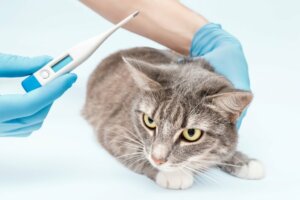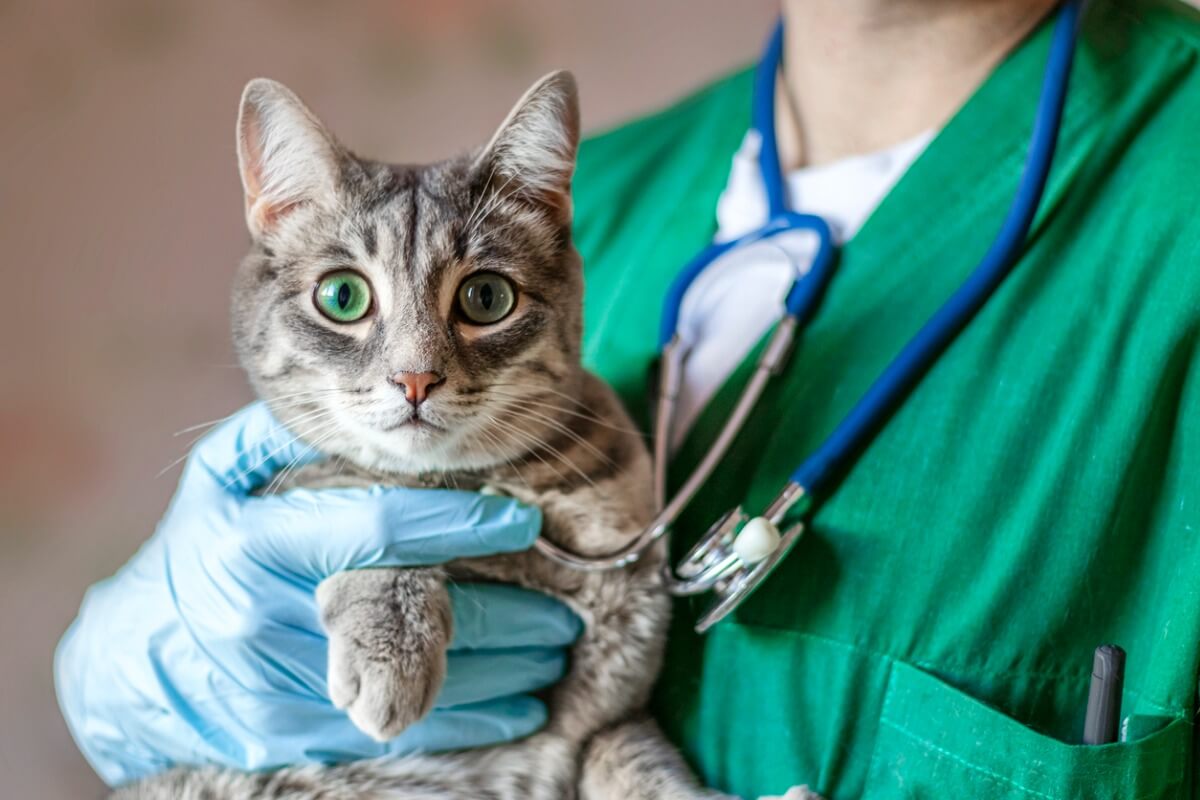Salmonellosis in Cats: Symptoms and Treatment

Salmonellosis in cats has a fairly low incidence rate. Although it produces symptoms similar to those that a human would have, in cats it’s easy to confuse it with other digestive ailments. However, this disease has a fatal outcome if not treated in time in almost all cases.
In this article, we’ll give you all the information you need to recognize salmonellosis in your pet and get to the vet in time, including diagnosis, pathological signs, treatment, and more. You’ll see that food prevention is the best weapon to end this pathology.
What is salmonellosis in cats?
Salmonellosis in cats is a bacterial disease caused by any microorganism of the Salmonella spp. complex, belonging to the Enterobacteriaceae family. These bacteria are naturally present in the intestinal tract of the cat (up to about 2000 types). During infection, they colonize the small intestine and mesenteric nodes.
If the disease isn’t treated, the bacteria eventually move into the blood (known as bacteremia), causing sepsis and ultimately the death of the animal. These microorganisms are resistant to gastric juices, bile salts and intestinal movements (peristalsis).
The Salmonella complex includes 6 subspecies, which include more than 2500 serotypes.

Causes of the disease
The main focus of infection of salmonellosis are the areas where animals considered farm animals live, such as chickens, cows and pigs, with birds being one of the main carriers. In addition, the bacteria can be spread by any route: water contaminated by their waste, meat, eggs, milk, and many more routes.
When contaminated water from these farms reaches rivers and other water sources, fruits and vegetables that are irrigated with it are also sources of infection.
A cat living near a reservoir of enterobacteria of this type can be infected in several ways. The most common is by consuming raw and contaminated products (milk and meat), but you can also get the disease by drinking dirty water or through raw and spoiled food, in which the bacteria have the opportunity to proliferate.
On the other hand, it should be noted that a cat can be a carrier of the bacteria and be asymptomatic. If the infection reaches its lungs, it could spread it through aerosols or during contact with saliva. Felines around you (especially immunocompromised and young felines) could contract salmonellosis through this route.
Cats are very prone to licking each other. For this reason, an asymptomatic carrier can infect an entire population in a short time.
Symptoms of salmonellosis in cats
Symptoms of salmonellosis appear as early as 12 hours after ingestion of the bacteria and can take up to 3 days to reduce in potency. The most common signs are as follows:
- Vomiting
- Diarrhea – this can sometimes be bloody and tends to be chronic and intermittent.
- Fever
- Weight loss
- Abdominal pain
- Dehydration
- Apathy
- Shock
Diagnosis
As you may have noticed, the symptoms of salmonellosis in cats could be confused with those of many other disorders, such as gastroenteritis, metabolic diseases, neoplasms and a long etcetera. Therefore, it’s necessary to carry out a differential diagnosis to rule out other ailments.
This is achieved through a stool culture, in which bacteria are allowed to proliferate in search of the one that concerns us, Salmonella. However, these tests take time to produce results (at least a week), so other complementary techniques are performed in the meantime. These are the following:
- Anamnesis: By consulting with the owner, it’ll be possible to know if the cat is living in an environment contaminated with the bacteria, is in contact with other infected cats, or has eaten some raw and suspicious food.
- Physical examination: This will allow the vet to detect inflammation of the abdomen and adjacent lymph nodes.
- PCR: This gives relatively quick results (about 3 days). It’s usually sent to external laboratories because of the difficulty of interpreting it correctly.
- Fecal cytology: Leukocytes – this test is used to directly observe the cells present in the stools and fecal mucus. In the presence of bacterial infections such as salmonellosis, the number of leukocytes observed will be high.
Treatment of salmonellosis in cats
The main treatment will be with antibiotics to combat the bacteria. During the period of antibiotic therapy it will also be necessary to treat the symptoms with fluid therapy, antipyretics, anti-inflammatories, probiotics and other methods that the patient may need.
Glucocorticoids may help to reduce the risk in cats with shock from infection.
Disease prevention
Cats living in rural environments and in contact with animals of other species are at increased risk of contracting salmonellosis. It’s always recommended that you don’t allow cats to freely roam outside, as there are many dangers they can expose themselves to unsupervised.
In addition, a cat may be an asymptomatic carrier of the disease and transmit the disease to other animals in the household, including humans.
It’s not recommended to feed domestic cats raw food. Any fresh food that’s offered to the feline must be properly refrigerated, in good condition and ideally boiled beforehand at high temperatures. Also remember to wash your hands after touching your cat, especially when you finish cooking.

A difficult disease to diagnose
As you’ve seen, salmonellosis in cats is a disease that’s impossible to diagnose through mere observation. Its low incidence in cats is an added difficulty, because other diseases are usually suspected beforehand.
So, if your cat has gastrointestinal symptoms, go to the vet immediately. In this way, the vet will be able to diagnose the most serious ailments. In animal health, prevention is always better than cure.
Salmonellosis in cats has a fairly low incidence rate. Although it produces symptoms similar to those that a human would have, in cats it’s easy to confuse it with other digestive ailments. However, this disease has a fatal outcome if not treated in time in almost all cases.
In this article, we’ll give you all the information you need to recognize salmonellosis in your pet and get to the vet in time, including diagnosis, pathological signs, treatment, and more. You’ll see that food prevention is the best weapon to end this pathology.
What is salmonellosis in cats?
Salmonellosis in cats is a bacterial disease caused by any microorganism of the Salmonella spp. complex, belonging to the Enterobacteriaceae family. These bacteria are naturally present in the intestinal tract of the cat (up to about 2000 types). During infection, they colonize the small intestine and mesenteric nodes.
If the disease isn’t treated, the bacteria eventually move into the blood (known as bacteremia), causing sepsis and ultimately the death of the animal. These microorganisms are resistant to gastric juices, bile salts and intestinal movements (peristalsis).
The Salmonella complex includes 6 subspecies, which include more than 2500 serotypes.

Causes of the disease
The main focus of infection of salmonellosis are the areas where animals considered farm animals live, such as chickens, cows and pigs, with birds being one of the main carriers. In addition, the bacteria can be spread by any route: water contaminated by their waste, meat, eggs, milk, and many more routes.
When contaminated water from these farms reaches rivers and other water sources, fruits and vegetables that are irrigated with it are also sources of infection.
A cat living near a reservoir of enterobacteria of this type can be infected in several ways. The most common is by consuming raw and contaminated products (milk and meat), but you can also get the disease by drinking dirty water or through raw and spoiled food, in which the bacteria have the opportunity to proliferate.
On the other hand, it should be noted that a cat can be a carrier of the bacteria and be asymptomatic. If the infection reaches its lungs, it could spread it through aerosols or during contact with saliva. Felines around you (especially immunocompromised and young felines) could contract salmonellosis through this route.
Cats are very prone to licking each other. For this reason, an asymptomatic carrier can infect an entire population in a short time.
Symptoms of salmonellosis in cats
Symptoms of salmonellosis appear as early as 12 hours after ingestion of the bacteria and can take up to 3 days to reduce in potency. The most common signs are as follows:
- Vomiting
- Diarrhea – this can sometimes be bloody and tends to be chronic and intermittent.
- Fever
- Weight loss
- Abdominal pain
- Dehydration
- Apathy
- Shock
Diagnosis
As you may have noticed, the symptoms of salmonellosis in cats could be confused with those of many other disorders, such as gastroenteritis, metabolic diseases, neoplasms and a long etcetera. Therefore, it’s necessary to carry out a differential diagnosis to rule out other ailments.
This is achieved through a stool culture, in which bacteria are allowed to proliferate in search of the one that concerns us, Salmonella. However, these tests take time to produce results (at least a week), so other complementary techniques are performed in the meantime. These are the following:
- Anamnesis: By consulting with the owner, it’ll be possible to know if the cat is living in an environment contaminated with the bacteria, is in contact with other infected cats, or has eaten some raw and suspicious food.
- Physical examination: This will allow the vet to detect inflammation of the abdomen and adjacent lymph nodes.
- PCR: This gives relatively quick results (about 3 days). It’s usually sent to external laboratories because of the difficulty of interpreting it correctly.
- Fecal cytology: Leukocytes – this test is used to directly observe the cells present in the stools and fecal mucus. In the presence of bacterial infections such as salmonellosis, the number of leukocytes observed will be high.
Treatment of salmonellosis in cats
The main treatment will be with antibiotics to combat the bacteria. During the period of antibiotic therapy it will also be necessary to treat the symptoms with fluid therapy, antipyretics, anti-inflammatories, probiotics and other methods that the patient may need.
Glucocorticoids may help to reduce the risk in cats with shock from infection.
Disease prevention
Cats living in rural environments and in contact with animals of other species are at increased risk of contracting salmonellosis. It’s always recommended that you don’t allow cats to freely roam outside, as there are many dangers they can expose themselves to unsupervised.
In addition, a cat may be an asymptomatic carrier of the disease and transmit the disease to other animals in the household, including humans.
It’s not recommended to feed domestic cats raw food. Any fresh food that’s offered to the feline must be properly refrigerated, in good condition and ideally boiled beforehand at high temperatures. Also remember to wash your hands after touching your cat, especially when you finish cooking.

A difficult disease to diagnose
As you’ve seen, salmonellosis in cats is a disease that’s impossible to diagnose through mere observation. Its low incidence in cats is an added difficulty, because other diseases are usually suspected beforehand.
So, if your cat has gastrointestinal symptoms, go to the vet immediately. In this way, the vet will be able to diagnose the most serious ailments. In animal health, prevention is always better than cure.
All cited sources were thoroughly reviewed by our team to ensure their quality, reliability, currency, and validity. The bibliography of this article was considered reliable and of academic or scientific accuracy.
- Greene CE, Salmonellosis en Greene CE (ed) Infectious diseases of the dog and cat,
Philadelphia, Pa: WB Saunders , 2006; 355-359. - Burboa Herrera, C. R. (2018). Detección de Salmonella en muestras de heces de gatos domésticos.
- AVEPA. (s. f.). DIAGNÓSTICO Y MANEJO DE ENFERMEDADES DEL APARATO DIGESTIVO FELINO. avepa.org. Recuperado 23 de noviembre de 2021, de https://www.avepa.org/pdf/proceedings/FELINO_PROCEEDING2013.pdf
- Wamsley, H. L. (s. f.). Citología Canina y Felina. BERRI. Recuperado 23 de noviembre de 2021, de https://www.berri.es/pdf/CITOLOGIA%20CANINA%20Y%20FELINA%E2%80%9A%20Atlas%20en%20color%20y%20gu%C3%ADa%20de%20interpretaci%C3%B3n/9788496344310
This text is provided for informational purposes only and does not replace consultation with a professional. If in doubt, consult your specialist.








